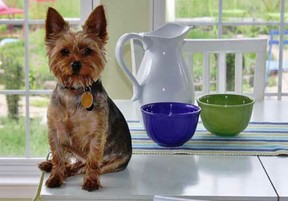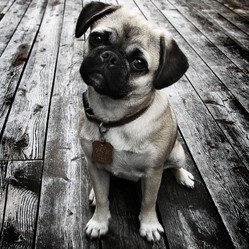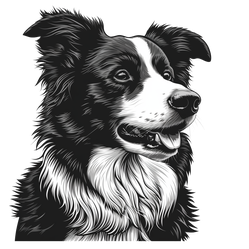Sometimes, staging your pet in a known setting can enhance the special qualities of your dog. A small dog for instance may benefit from being photographed off the floor. This makes your pet look not only bigger but more important and dominate the shot.

Image credits
Most of the time however the background should be kept as plain as possible, preferably contrasting in tone with the dog's coloring. It is a mistake to pose a black or brown dog against a background in shadow, or a light-coated dog against a white or sunlit wall. Bare brick walls and trellis-work fences should be avoided along with all backgrounds with an assertive pattern or texture. The mottled shadow pattern of foliage and trees, and the spotty effect of light-coloured flowers are examples of backgrounds that have ruined more than one good photograph.
A plain neutral-coloured piece of cloth or blanket without folds or creases makes an admirable background- dark for light subjects, and grey or cream for dark. The background should be supported about three to four feet away from the animal, so that it can be thrown out of focus and kept free from the dog's own shadow. If the camera has a fixed focus lens, even greater care must be taken to see that the background is free from folds or creases.
The blue sky makes an excellent background; to make use of it, the dog must be made to stand on a low wall or the roof of a shed. Under these circumstances a colour filter must be used to correct over-sensitivity of the material to blue, so as to give tone to the sky area. It is better to choose a cloudless blue part of the sky than to include distracting cloud shapes. When, using the sky as a background, it is wise-to watch out for neighboring chimneys, pets and antennaes. The filter, of course, calls for an increase in exposure.









 Photographic Styleon 10/14/2011
Photographic Styleon 10/14/2011
 Interchangeable Lenseson 09/28/2011
Interchangeable Lenseson 09/28/2011
 Negative Blisters and Blemisheson 09/17/2011
Negative Blisters and Blemisheson 09/17/2011
 Photographyon 08/22/2011
Photographyon 08/22/2011



Comments
Wow! I don't write here on Wizzley but you have done a fine job and they should be grateful to have you, this is an amazing article on photographing dogs!